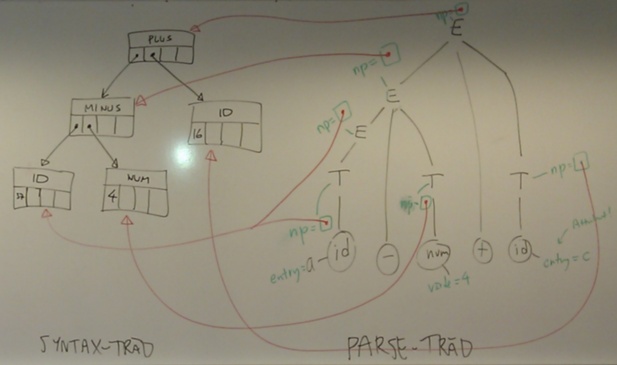
These lecture notes are my own notes that I made in order to use during the lecture, and it is approximately what I will be saying in the lecture. These notes may be brief, incomplete and hard to understand, not to mention in the wrong language, and they do not replace the lecture or the book, but there is no reason to keep them secret if someone wants to look at them.
Idag: Syntax-styrd översättning. Att bygga syntaxträd.
Attributes:
Annotating or decorating a parse tree = calculating attribute values
Attribute x depends on attribute y.
Ex: E.val depends on E1.val and E2.val
(A dependency graph shows dependencies between attributes in nodes, and can be used to determine the evaluation order of nodes.)
Attribute grammar = no side effects in the semantic rules
S-attributed definitions = a syntax definition with only synthesized (=S) attributes
Attribute values of terminals (=tokens) are supplied by the lexical analyzer. A token has no inherited attributes.
Med den här grammatiken:
|
E -> E1 + T | E1 - T | T
T -> ( E ) | id | num |
But: terminology!
We can generate code (initermediate or target) (or calculate a result in a calculator) directly while parsing...
...or we can build a syntax tree, and then generate code (or caluclate a result) from the tree.
(Remember from föreläsning 5:)
#define MAX_ARGS 4
enum TreeNodeType { IF, WHILE, PLUS, MINUS, TIMES };
struct TreeNode {
enum TreeNodeType type;
struct TreeNode* args[MAX_ARGS];
};
Ex igen: a-4+c
ALSU-07 fig. 5.10 (ASU-86 fig. 5.9): Syntax-directed definition for constructing a syntax tree for an expression:
| Production | Semantic Rule |
|---|---|
| E -> E1 + T | E.nptr = mknode('+', E1.nptr, T.nptr) |
| E -> E1 - T | E.nptr = mknode('-', E1.nptr, T.nptr) |
| E -> T | E.nptr = T.nptr |
| T -> ( E ) | T.nptr = E.nptr |
| T -> id | T.nptr = mkleaf(ID, id.entry) |
| T -> num | T.nptr = mkleaf(NUM, num.entry) |
Result for a-4+c:
Later:
The course Compilers and interpreters | Lectures: 1 2 3 4 5 6 7 8 9 10 11 12